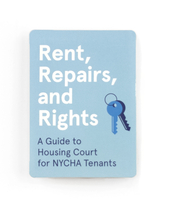 TGNC-NYC
TGNC-NYC
For Transgender, Gender Nonconfirming, and Nonbinary (TGNCNB) people, navigating critical city services like the shelter system or accessing healthcare can be an overwhelming and often traumatic process. In addition to the many bureaucratic obstacles of accessing services, TGNCNB people often face unjust treatment and transphobia throughout the process.
To support TGNCNB people, the city recently created the position of Gender Liaisons who work at specific city agencies and advocate for and help individuals access the services they need. But few people know that Gender Liaisons exist and that TGNCNB people have the right to fair and just treatment.
CUP collaborated with the New York City Anti-Violence Project (AVP) and designer Erik Freerto create TGNCY-NYC, a pocket-sized, foldout guide, which helps TGNCNB people understand how to access and work with Gender Liaisons. The guide includes detailed information on how to find and work with a liaison, with sample language to use when talking to city employees. TGNC-NYC also includes rights that TGNCNB people have in NYC and steps to take if they face transphobia.
AVP will distribute thousands of guides throughout their network of TGNC individuals and advocates.
- 3.5”x5.5”
- $3.00




















